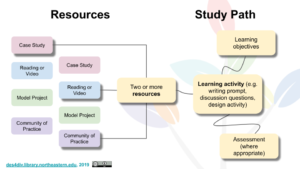The format covers the different types of materials used in this Toolkit.
Study Paths contain learning activities that use the resources within the Toolkit and serve as guided routes to using the collection.
Resources are the materials that are used within the study paths and orientations. There are four main resources in this current version of the Toolkit: the case studies, secondary resources such as videos or readings, communities of practices, and model projects.
Case Studies, more specifically, were written as short, concrete reflections on real-world challenges and examples exclusively for Design for Diversity. Case studies explore how a particular situation and set of outcomes were shaped by local circumstances (cost constraints, people, work practices, content, environment, audience, etc.) and yield insight into the impact of specific factors and influences.
Study Paths
Study Paths contain learning activities centered on the resources in this Toolkit, and serve as guided routes through the readings, case studies, model projects, and communities of practice gathered here. Study paths combine one or more resources with a prompt or suggested activity such as a hands-on assignment, group discussion topic, or reflective written paper that could be used in the context of a class, workshop, or personal study. Study paths can be used as standalone activities, or linked together to provide a course of study over a longer period of time.

Study paths have been written and revised by the Toolkit Core Design Group, the Design for Diversity Grant Team, and attendees of the August 2018 Writing Sprint.
Resources
Resources are case studies, texts, model projects, and communities of practice that can be browsed directly or in more structured ways through study paths. This Toolkit presents a selection of the resources we found most impactful, but a larger (400 and counting) master bibliography is stored as a Zotero library with topical keywords to assist in searching and organization.
Case studies have been written specifically for Design for Diversity, and we offer thanks to all of our case study authors.
Short, concrete reflections on real-world challenges and examples, providing grounded examples for students and professionals to think with. In relation to more theoretical and speculative texts, the case studies offer specific, situated knowledge arising from practical experience. Case studies explore how a particular situation and set of outcomes were shaped by local circumstances (cost constraints, people, work practices, content, environment, audience, etc.) and yield insight into the impact of specific factors and influences. Case studies are a format for capturing and sharing knowledge that isn’t typically included elsewhere.
Multimodal collection of texts on topics relevant to the D4D topic areas, including articles, books, websites, reports, videos, audio clips, standards, presentations, and other materials. For transparency purposes, we want to address a few gaps in our choices:
Due to intellectual property rights, the “texts” provided are only the bibliographic information and some of these texts are locked behind paywalls.
We are deeply appreciative to feedback pointing out that most of the “texts” chosen are readings; we hope as this toolkit develops, the selections become more diverse. The word “text” itself privileges reading. We chose “text,” though, because in recent communities, “text” has now been more commonly used to refer to multimodal objects incorporating video and sound.
Gathering places (either in-person, such as conferences, or online, such as email lists and other virtual toolkits) where issues of inclusion in cultural heritage information systems are discussed. We hope this toolkit can be a way to connect like-minded colleagues with each other.
Examples of projects that center issues of inclusion in cultural heritage information systems. We have taken inspiration from these projects during the development of this Toolkit, and hope to point more cultural heritage practitioners to them.
 Print This Page
Print This Page

